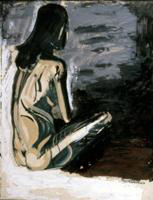
José Clemente Orozco
Mexican, 1883-1949
Meditating Woman, 1943 ca.
tempera on paper
25 3/4 x 19 3/4 in.
SBMA, Gift of Mr. and Mrs. Warren Tremaine
1973.54.1

Orozco self-portrait, detail from one of his murals
"Art is not an imitation nor an ethnological curiosity staged for tourists. Only when an artist realizes perfectly which is his right and proper function in the social body, and sees with his own eyes, feels with his own heart and thinks with his own mind, will appear a new art on the American continent, the creation of a new race." - José Clemente Orozco
COMMENTS
Born in Jalisco, Mexico, Orozco is acknowledged as one of the three greatest muralists of the twentieth century. In fact, one of his works at Pomona College is considered by art historians to be the first great mural in the west. Orozco is usually seen as one of Mexico’s finest artists; however, because most of his works are murals he is relatively less well known than many of his European contemporaries. In earlier works we can see that he had a most thorough grounding in the academic exercises of depicting reality through knowledge of anatomy, perspective, normal light, and shade. In later works we see his enormous knowledge freely used for the exaggerative needs of satire in his art. His desire was to help his country rise out of medieval poverty and awaken a fire within them.
Orozco was rigorously trained, his style being firmly based on academic discipline but without reference to prevailing European theories. He used the human form as the primary expressive agent and was not so concerned with the stylistic manner of his painting as with its constantly mounting power and conviction. His painting is devoid of individuals; he creates types, identifies their meaningful gestures, but they remain faceless and anonymous. In this way he is most similar to Goya. The singular instant, or the specific point of view is obliterated. What remains are the raw images of oppression. The great dramatic sense of Spanish artist is present in all of the works by Orozco, as is the terrifying expression of the monumental sculpture of the Aztecs. His vision as a painter was monochromatic, like certain Italian artists of the Renaissance. Even when some of his murals are full of color, the pigments never serve to construct the forms, but only to illuminate.
Orozco was a proud, reticent man whose business was painting and whose life was devoid of theatrics. As he submitted his memoirs he wrote, “[T]here is nothing of special interest in it, no famous exploits or heroic deeds, no extraordinary or miraculous happenings. Only the uninterrupted and tremendous efforts of a Mexican painter to learn his trade and find opportunities to practice it.”
Orozco first visited the United States in 1917 and again from 1927 to 1934…the later interlude, which saw the creation of the Pomona frescoes, those of the New School for Social Research, and those of Dartmouth College. In 1934 he returned to Mexico to execute in Guadalajara the three fresco cycles which remain without parallel in the western world….
Orozco was a rigorously trained artist…Slowly he developed his powerful individual style, firmly based on academic discipline, without reference to prevailing European theories.
Orozco, like Picasso, uses the human form as the primary expressive agent. He is not so inventive as Picasso in so doing, but fully as eloquent. Orozco was not so sharply concerned with the stylistic manner of his painting as with its constantly mounting power and conviction.
His painting is devoid of individuals. He creates types, identifies their meaningful gestures, but they remain anonymous and faceless. In this he is most similar to Goya of “Los Caprichos” and “Los Proverbios”, in which the singular instant, or the specific point of view, is obliterated, and what remains is his anguish that war and murder and injustice occur.
The great frescoes in Guadalajara have a scale, a power, and an intensity that in comparison make a large portion of contemporary art seem decorative and mannered. There is much justification for considering Orozco the major artist of the twentieth century. Certainly he is one of that small handful of Titans who have made our century the most creative in modern history.
- John Palmer Leeper, Marion Koogler McNay Art Institute, in José Clemente Orozco: An Autobiography, University of Texas Press, Austin, 1962
